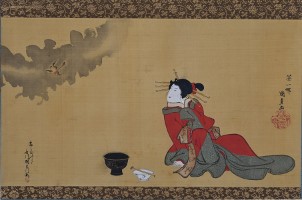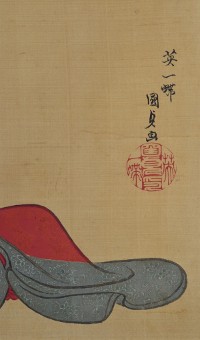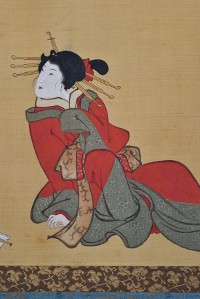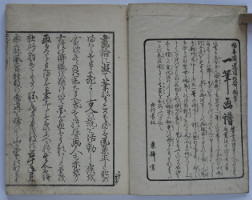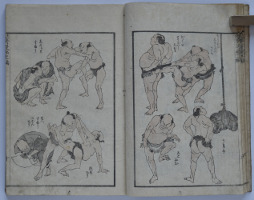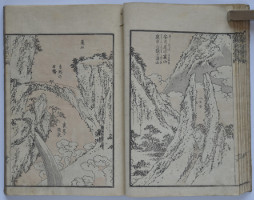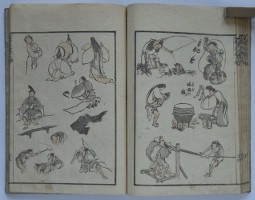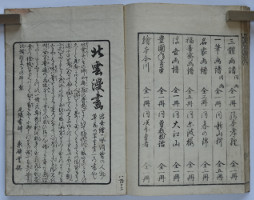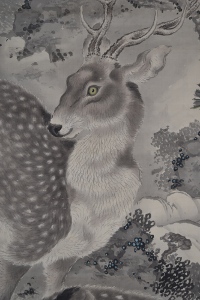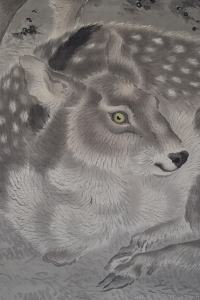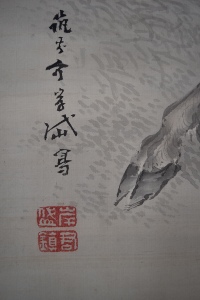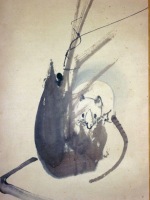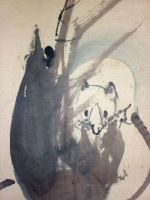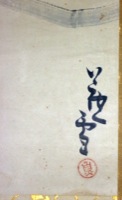Utagawa KUNIYOSHI (1797-1861)
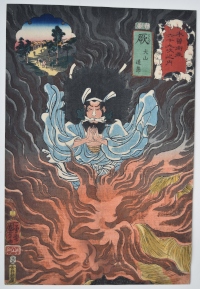
Click here to view image full size.
Inuyama Dosetsu, one of the eight dog heroes, enveloped in a conflagration. The heroes represent a Confucian ideal or Buddhist regulation and meet various adversaries in the epic Nanso satomi hakkenden, “Biography of the Eight Dogs” written by Takizawa Bakin between 1814 and 1842. Dosetsu is gifted with magic fire and is seen here with pine sprigs wrapped in paper clenched between his teeth. The subject represents Warabi Station (seen top left) from a set Kisokaido rokujuku tsugi, “Sixty-nine Stations along the Kisokaido.” In fact, a pun on the word warabi which can also mean “straw fire.” The bales can be seen bottom right. Published by Izutsuya Shokichi 1852. The best design from the set.
ga.
Fine impression and colour. Lightly backed and very slight vertical fold, otherwise very good condition. Signed Ichiyusai Kuniyoshi
Status: Available
Tsukioka YOSHITOSHI (1839-1892)
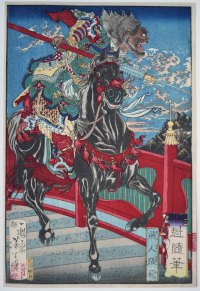
Click here to view image full size.
Shows the warrior Zhang Fei (Jap. Yokutoku) awaiting his rival Cao Cao on Changban bridge. Fei tricks his enemy into thinking he leads a vast army by dragging logs from a nearby forest causing a huge dust cloud. Cao Cao retreats. The story is from the Romance of the Three Kingdoms (Chi. Sanguo yanyi). From the set Ikkai zuihitsu, “Essays by Yoshitoshi.” (Ikkai was an early name of Yoshitoshi’s.) A set of thirteen prints published by Masadaya Heikichi 1872/3. A fine set.
Extremely fine impression and colour from the first edition. Fine burnishing on the horse. Most designs from the set have red seals in the margin and red seals over the signature. These were removed on later editions. Margins trimmed a little, otherwise fine condition. Signed Ikkaisai Yoshitoshi hitsu.
Status: Available
Tsukioka YOSHITOSHI (1839-1892)
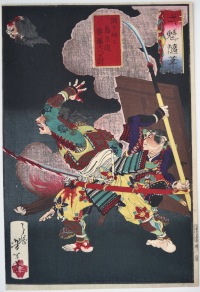
Click here to view image full size.
Shows the bloodied western army commander, Shima Sakon, having severed the head of Sato Daihachi, which flies through the air at Horagatoge Pass. Sakon lead an army of his Lord Ishida Mitsunari against the future Shogun Tokugawa Ieyasu at the battle of Sekigahara in 1600. From the set Ikkai zuihitsu, “Essays by Yoshitoshi.” (Ikkai was an early name of Yoshitoshi’s.) A set of thirteen prints published by Masadaya Heikichi 1872/3. A fine set.
Extremely fine impression and colour from the first edition. (There were no red seals on the first edition of this design.) Trimmed on black border at left, otherwise fine condition. Signed Ikkaisai Yoshitoshi hitsu.
Status: Available
Tsukioka YOSHITOSHI (1839-1892)
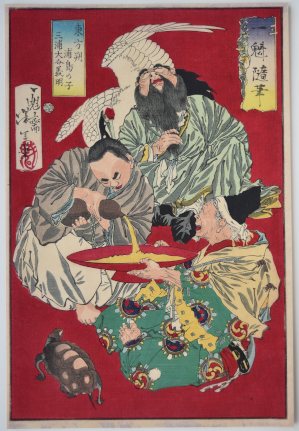
Click here to view image full size.
Shows Tobosaku (who stole the Peaches of Immortality), Miura Daisuke Yoshiaki (Lord of Kinugasa castle), and the son of Urashima Taro (who saved the sea turtle and was carried to the Dragon King’s Palace) drinking wine. From the set Ikkai zuihitsu, “Essays by Yoshitoshi.” (Ikkai was an early name of Yoshitoshi’s.) A set of thirteen prints published by Masadaya Heikichi 1872/3. A fine set.
Extremely fine impression and colour from the first edition. (No seals on the first edition.) Margins trimmed a little, otherwise fine condition. Signed Ikkaisai Yoshitoshi hitsu.
Status: Available
Utagawa Toyokuni II (1777-1835)
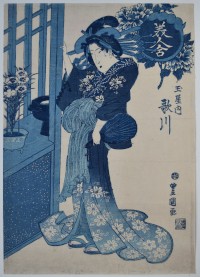
Click here to view image full size.
An aizuri-e (blue print) showing the courtesan Utagawa of Tamaya admiring a bowl of carnations. From a set Bijin awase published by Shimizu, c. late 1820s. These blue prints using the imported bero, Berlin blue (what we called Prussian blue), became popular during the 1820s to 1840s as the cost came down.
Fine impression and colour. Trimmed slightly, otherwise very good condition. Signed Toyokuni ga.
Status: Available
Ryuryukyo SHINSAI (1764-1820)

Click here to view image full size.
An original painting, sumi and light colour on silk, 32 x 11 in; 81.3 x 28 csms. Shows three classes in Japanese society: Farmer’s wife, Priest and a Samurai, forced to shelter together at the entrance to a Shinto shrine from a sudden downpour of rain. Above, a rooster and hen also shelter. These birds were allowed to roam freely around Shinto Temples. Shinsai was one of Hokusai’s best pupils. Known for his fine surimono and paintings. Signed Ryuryukyo Shinsai with Ryuryukyo seal. In good condition.
Status: Available
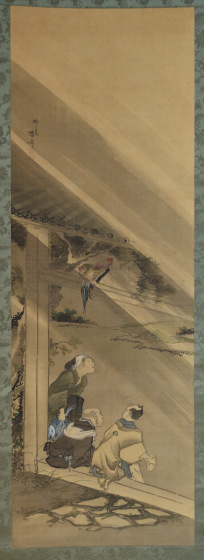
Click here to view image full size.
Ichiryusai HIROSHIGE (1797-1858)
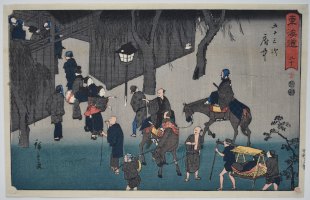
Click here to view image full size.
Fuchu from The Fifty-three Stations of the Tokaido published by Marusei, Maruya Seijiro, 1847-52. Called the Reisho Tokaido because of the angular style of Kanji used. Travellers coming and going at the entrance to the station. One of the best designs from the set. Provenance: Ex Hayashi collection with seal below title cartouche.
Fine impression and colour. Very good condition. Signed Hiroshige ga.
Status: Available
Hishikawa MOROSHIGE (Fl. 1684-1704)

Click here to view image full size.
An original painting, sumi and full colour on paper, 24 x 12 in; 61 x 30.5 cms. Shows a beautiful youth (a wakashu) dressed as a girl with his attendant servant. These youths (identified as male by wearing a sword) were arbiters of trend-setting kimono design. They are sometimes referred to as the “third gender,” and were sexually ambiguous being objects of desire to both adult men and women. Moroshige was the senior pupil of Hishikawa Moronobu, and, it is said, was the father of Furuyama Moromasa. Some toning of paper and slight loss of pigment, but all commensurate with a painting of this age. Otherwise good condition. Painted around 1700.
Signed Hishikawa Moroshige zu with seal Moroshige. A fine and interesting painting.
Status: Available
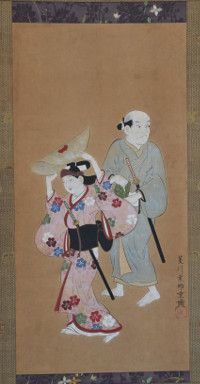
Click here to view image full size.
Toba HIROMARU (Active 1804-1818)

Click here to view image full size.
An original painting showing a parading courtesan. Sumi and colour on paper, 45.5 x 11.25 in; 115.5 x 28.5 cms. A rare artist of the Utagawa school. Probably a pupil of Utagawa Toyohiro. His extant paintings show a considerable talent with particularly attenuated faces. Another example is in the MFA, Boston, acc. no. 11.7369 as well as there having been two sold at auction: Christies, NY 16/9/2003, lot 153 and Bonhams NY 18/3/2015, lot 3010. Some minor marks and creasing, but otherwise good condition. Signed Toba Hiromaru hitsu. Seal unread.
Status: Available

Click here to view image full size.
Toyohara KUNICHIKA (1835-1900)
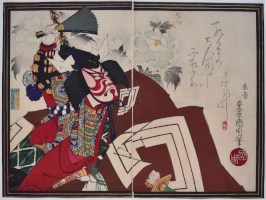
Click here to view image full size.
A diptych showing the actor Ichikawa Danjuro IX as Kamakura Gongoro Kagemasa in the drama Shibaraku, “Just a moment.” The large sansho (three square) motif was the symbol of the Danjuro clan and is repeated around the border. In the background are peonies, also associated with the Danjuro clan. Published by Tanaka Katsuzo, 1878.
Fine impression, colour and condition. Signed Oju Toyohara Kunchika hitsu.
Status: Available
Utagawa KUNIYOSHI (1797-1861)
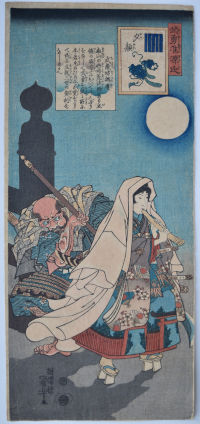
Click here to view image full size.
An o-tanzaku print, Yugao chapter from the fifty-four chapters of Genji, the Genji Monogatari. A tenth century romance written by Murasaki Shikibu. From a set Buyu nazoraye Genji, “Heroic Comparisons for the Chapters of Genji.” In this case showing Benkei creeping up on Ushiwaka on Gojo Bridge in Kyoto. The story relates how Benkei only needs one more blade to add to the 999 he has wrenched from samurai attempting to cross the bridge in order to fashion an invincible weapon. Benkei loses the fight and becomes Yoshitsune’s loyal retainer. Published by Ibaya Sensaburo, c. 1843.
Fine impression and colour. Very good condition. Signed Cho-o-ro Kuniyoshi ga.
Status: Available
Tsukioka YOSHITOSHI (1839-1892)
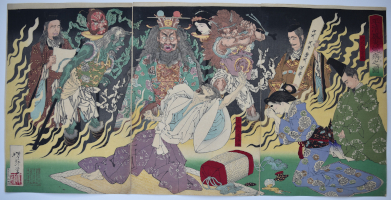
Click here to view image full size.
A triptych Taira Kiyomori hi no yamai no zu, “The Fever of Taira no Kiyomori.” Kiyomori’s wife, Niidono, dreams that the King of Hell, Ema, is coming for Kiyomori for his crime of burning the Rushana Buddha. His family gather around him and pray but to no avail. He dies on the 4/2/1181. Shows Niidono and her son beside a convulsed Kiyomori. Behind are visions of hell with Ema and figures who may have been Kiyomori’s victims. Published by Akiyama Buemon, 1883.
Fine impression, colour and condition. A lovely copy of this triptych. Signed Yoshitoshi ga.
Status: Available
Utagawa KUNIYOSHI (1797-1861)
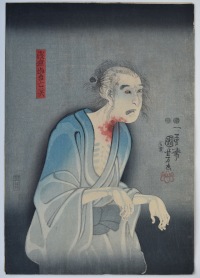
Click here to view image full size.
Ichikawa Kodanji IV as the ghost of Asakura Togo in the play Higashiyama Sakura zoshi, “The Story of Sakura of Higashiyama.” Based on historical events in 1653 with the characters’ names changed (Asakura Togo was actually Sakura Sogoro). The story tells of a village chief who was forced to witness the beheading of his sons before being crucified by the cruel samurai Lord Hotta Kozuki, after he had protested at the levy of unfair taxes. Sakura’s ghost returns to haunt Hotta’s castle. In fact the left sheet of a diptych. However, nearly always sold as a single sheet as the other side does not marry up, is undistinguished and was probably sold separately. Published by Sumiyoshi Masagoro, 1851. Beside the signature is the seal shita-uri, “low sale” meaning it was sold “under the counter” due to censorship laws prevalent at the time. This is the very rare first edition with the carver’s seal Hori Take, Yokokawa Takejiro, to the right of the publisher’s seal on the left. This was removed on later editions. One of the great ghost prints.
Fine impression, colour and condition with gum applied to the eyes (only found on the first edition).Signed Ichiyusai Kuniyoshi ga.
Status: Available
Utagawa HIROSHIGE II (1829-1869)

Click here to view image full size.
An original painting, full colour on silk, 37 x 14 in; 94 x 35.5 cms. The pupil of Hiroshige I who gave him the name Shigenobu. Adopted by Hiroshige in 1845 and married his daughter, Otatsu, on Hiroshige’s death. (Later divorcing her around 1865.) Shows a beauty cooling off on the prow of a boat beneath a full moon and the trestles of a bridge. (Probably the Ohashi over the Sumida River.)
In very good condition and possibly his best painting. Signed Hiroshige ga, seal unread.
Status: Available
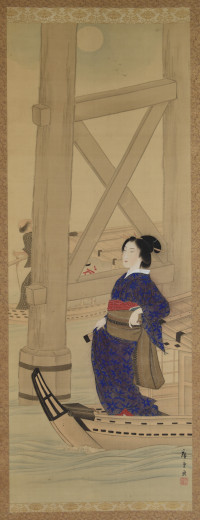
Click here to view image full size.
Utagawa HIROSHIGE II (1826-1869)
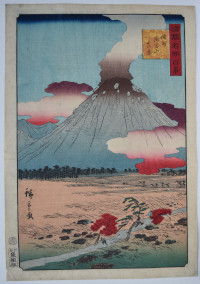
Click here to view image full size.
A view of a smoking Mt Asama, Shinano Province, from Shokoku meisho hyakkei, the “One Hundred Views of Famous Places in the Provinces.” Mt Asama is an active volcano which violently erupted in 1108. Subsequently there was another eruption in 1783 and since then there have been minor tremors. Published by Uoya Eikichi between 1859 and 1861 (this being 1859).
Fine impression, colour and condition. Signed Hiroshige ga.
Status: Available
Toyohara KUNICHIKA (1835-1900)
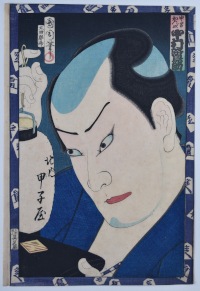
Click here to view image full size.
The actor Nakamura Shikan IV as Ishikawa Hachizaemon in the play Chuko musashi no abumi staged at the Nakamura-za Theatre in 4/1869. From a set of at least 22 prints published by Gusokuya Kahei, 1869. Kunichika was a hack artist who nevertheless produced some fine triptychs (horizontal and vertical) and this fine set of actor bust portaits.
Fine impression and colour. Minor edge soil, otherwise very good condition. Signed Kunichika hitsu.
Status: Available
Shunbaisai HOKUEI (Active 1824-1837)
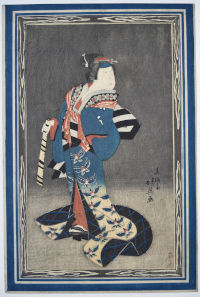
Click here to view image full size.
Shows the actor Arashi Rikan II as the yako Koman holding a shakuhachi and posed within a wooden frame in the play Sugata kurabe deiri no minato, “Comparison of Fighting Figures at the Harbour.” Performed in 1834 at the Naka Theatre, Osaka. A yako was a chivalrous servant, usually of a samurai. Rare: Another impression is in the MIA, acc. no P.75.51.188.
Fine impression with the woodgrain enhanced on the background. Fine colour and condition. Signed Shunbaisai Hokuei ga with the carver’s seal bottom right Kasuke.
Status: Available
Kitagawa UTAMARO II (Fl. c 1807-1830s)
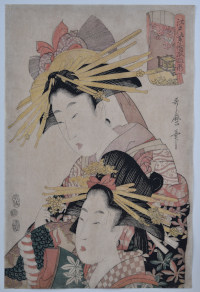
Click here to view image full size.
A courtesan and her Shinzo from a set Edo murasaki edoru hinagata, “Models Designed in the Purple of Edo.” A bluish purple as opposed to the more reddish purple from Kyoto. A pigment that had been extremely expensive and reserved for the elite few, but became cheaper and more accessible during the Edo period, fuelled by leading actors – such as Danjuro – wearing an Edo murasaki headband. Published 11/1807. Publisher unread.
Very good impression, colour and condition. Signed Utamaro hitsu.
Status: Available
Utagawa KUNISADA (1786-1865)
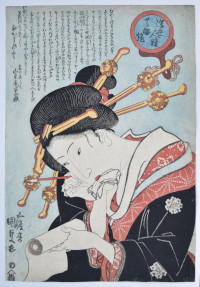
Click here to view image full size.
A courtesan biting on a tissue about to write a love letter from the set Ukiyoe jinsei tengankyo, “Types of the Floating World Seen Through a Physiognomist’s Glass.” The glass top right. These professionals who purported to look at people’s features and give counsel based on their countenance were called Ninsomi or simply Somi. This set of ten prints showing different female personalities have their characteristics written up above. Utamaro produced two fine sets based on this theme in 1792-4 and c 1802: Fuji ninso jupon and Bijin gomenso. The clenching of the tissue is always an indication of arousal. Published c 1830 by Moriya Jihei (Kinshindo).
Fine impression with blind-printing. Fine colour. Small repaired binding holes and very slight trimming, otherwise very good condition. Signed Gototei Kunisada ga.
Status: Available
Utagawa KUNIYOSHI (1797-1861)
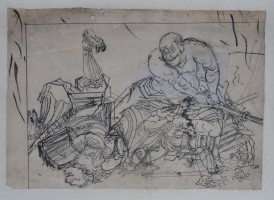
Click here to view image full size.
An original drawing, sumi on thin paper laid onto Japanese paper, 6.5 x 9.25 in; 15.9 x 23.5 cms. A heavily muscled individual (Benkei ?) dispatching two adversaries. Sold “as is” with all imperfections common to surviving drawings. Two areas of pentimenti.
Status: Available
Utagawa KUNISADA (1786-1864)
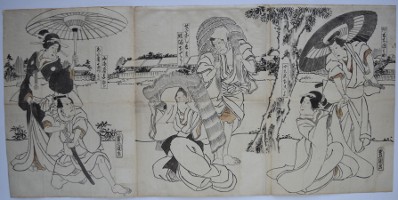
Click here to view image full size.
An original hanshita-e (preparatory drawing) for a triptych showing, from the left, Nakamura Kamenojo I as the geisha Azuma standing above Kawarasaki Gonjuro I as Yamazakiya Yogoro, Bando Kamezo I as Settanaoshi Chogoro standing above Onoe Kikugoro IV as Kumasaka Ocho, and Onoe Kikugoro IV as Akogi Gennojo standing above Onoe Kikujiro II as Onnadayu Okoyo. The play was Yume musubu cho ni torioi performed at the Ichimura-za theatre 3/1856. These first drafts by the artist themselves survive because a more detailed drawing was needed by the blockcutter, and this was normally given to an assistant to execute. Or the drawing was never taken up by the publisher, for whatever reason. Sumi and touches of red with some pentimenti. (This was also most likely a published print by Sanoki as it is from the same group as others offered here.) Signed on two sheets Toyoukuni ga.
Status: Available
Utagawa KUNIYOSHI (1797-1861)
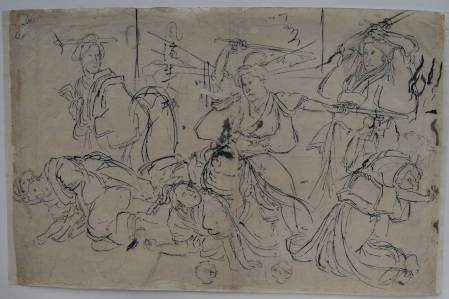
Click here to view image full size.
A fine large original drawing, sumi on thin paper, 12 x 18.5 in; 30.4 x 47 cms. Shows battling women holding what appear to be wooden swords. Two seals at the bottom which appear to be the publisher Honmo who published 1855-56. Provenance: Ex collection Dr. Julius Kurth (1870-1949), an eminent scholar who wrote extensively on Japanese and Chinese art.
Sold “as is” but in good condition.
Status: Available
Tsukioka YOSHITOSHI (1839-1892)
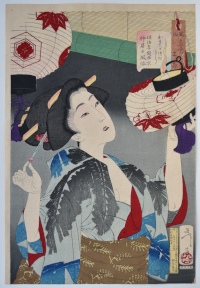
Click here to view image full size.
Okigatsuki-so: Meiji nenken saikyo nakai no fuzoku, “Looking Capable: The Appearance of a Kyoto Waitress in the Meiji Era [1867-1912].” Shows the waitress of a Kyoto geisha house whose job was to act as a go-between for customer and geisha. From a set Thirty-two Aspects of Women published by Tsunashima Kamekichi, 1888. The set depicts women of different backgrounds and occupations from the Kansei era through to the Meiji era with punning allusions to their situation or mood.
Very fine impression of the true first edition. Fine colour and condition. Signed Yoshitoshi ga.
Status: Available
Tsukioka YOSHITOSHI (1839-1892)
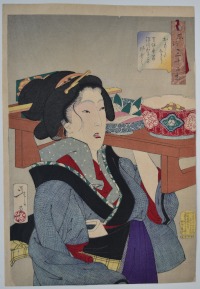
Click here to view image full size.
Omota-so: Tempo nenkan Fukagawa karuko no fuzoku, “Looking Weighed-Down: The Appearance of a Waitress at Fukagawa in the Tempo Era [1830-1844].” Shows the waitress carrying a portable wooden table with food to a geisha party from a set Thirty-two Aspects of Women published by Tsunashima Kamekichi, 1888. The set depicts women of different backgrounds and occupations from the Kansei era through to the Meiji era with punning allusions to their situation or mood.
Very fine impression of the true first edition. Fine colour and condition. Signed Yoshitoshi ga.
Status: Available
Utagawa HIROSHIGE (1797-1858)
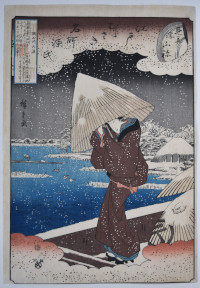
Click here to view image full size.
One of a set: Edo Murasaki meisho Genji, “Murasaki’s Genji in Famous Places of Edo.” Mitate Ukifune Sumidagawa no watashi, “A Parody of Ukifune Crossing the Sumida River.” Shows a beauty on a ferry crossing the Sumida River in heavy snow, representing Ukifune, one of the court ladies of the Genji Monogatari. Stylised clouds above and below copying the traditional kiri-gane gold found on Yamato-e scrolls. These Genji pictures were popular at this time to circumvent the reforms of 1842. Published by Kinseido (his seal also appearing on the umbrella bottom right). Rare.
Fine impression. Very good colour. Lower margin trimmed close, otherwise very good condition. Signed Hiroshige ga.
Status: Available
Utagawa KUNISADA (1786-1864)
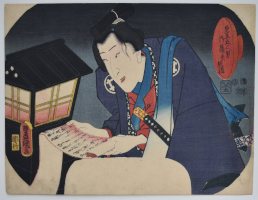
Click here to view image full size.
A fan print showing the actor Bando Shuka I as Shirai Gonpachi from a set Mitate gonin otoko, go-hiiki no omoizashi, “A Parody of the Five Chivalrous Commoners: A Cup of Sake From Their fans.” Omoizashi means to pour sake for one’s loved one and indicates the adoration of the fans for their actors. Published by Yama-Ta, 2/1852.
Very good impression, colour and condition. Signed Toyokuni ga.
Status: Available
Toyohara KUNICHIKA (1835-1900)
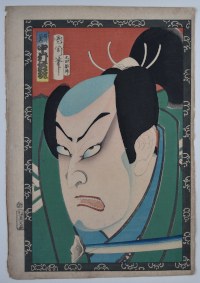
Click here to view image full size.
The actor Nakamura Sagisuke in the role of the samurai attendant Kanji (Chugen Kanji) in the play Kichisama mairu yukari no otozure which was premiered at the Nakamura-za Theatre 15/7/1869. From a set of at least 22 prints published by Gusokuya Kahei, 1869. Kunichika was a hack artist who nevertheless produced some fine triptychs (horizontal and vertical) and this fine set of actor bust portaits.
Fine impression and colour. Slight trimming, otherwise very good condition. Signed Kunichika hitsu.
Status: Available
Toyohara KUNICHIKA (1835-1900)
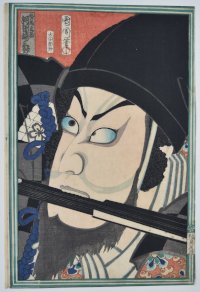
Click here to view image full size.
The actor Kawarasaki Sansho (later Ichikawa Danjuro IX) in the role of Sato Masakiyo in the Momoyama Goten Ohiroma scene from Momoyama Monogatari performed at the Ichimura-za Theatre, 8/1869. From a set of at least 22 prints published by Gusokuya Kahei, 1869. Kunichika produced some fine triptychs (horizontal and vertical) as well as this fine set.
Fine impression and colour. Slightly trimmed, otherwise very good condition. Signed Kunichika hitsu.
Status: Available
Shunkosai HOKUEI (FL. 1829-1837)
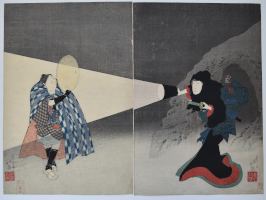
Click here to view image full size.
A dramatic diptych showing the actor Iwai Shijaku I as Lady Osuma shining her lantern on the actor Bando Jutaro as Sasaya Hanbei from the play Honobonoto ura no asagiri, “Daybreak Hidden on the Bay by Morning Fog.” A revenge drama performed at the Naka no Shibai, Osaka, 9/1832. Hanbei is an accomplice of the villain in the play, Karahashi Daisuke. The confrontation takes place immediately after he has murdered the fiancée of the play’s hero, Kowari Dennai, by throwing her off a cliff. He makes his escape by throwing shuriken (star-shaped throwing blades) at Osuma.
Very fine impression. This is a de-luxe edition of the first state “surimono-style.” The hand-stamped block cutter’s seal “surimono cut by Kasuke” bottom left of second sheet. A later edition missing seal was published by Iden. Fine colour with burnished pattern on Osuma’s costume and the poem above is written in metallic pigment. Fine condition. Signed Shunkosai Hokuei ga with seal fumoto no yuki.
Status: Available
Utagawa KUNISADA (1797-1861)
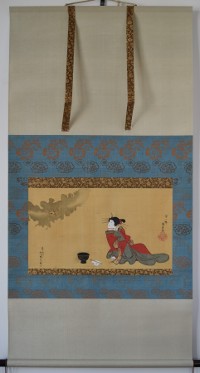
Click here to view image full size.
A fine and interesting original painting, full colour on silk, 11.25 x 20.25 in; 28.5 x 51.5 cms. Shows a reclining beauty looking up at a cuckoo (hototogisu) flying in clouds. The cuckoo is the harbinger of the summer months. This painting, made c 1830, reflects Kunisada’s study, together with Ikkei, of the work of Hanabusa Itcho (1652-1724). Indeed, Ikkei gave Kunisada the name Hanabusa Ittai and this painting is signed Hanabusa Itcho Kunisada ga with seal Hanabusa Ittai Kunisada no in. To the bottom left is an inscription reading “A disciple of Utagawa Kunisada drawn on request [the cuckoo].” There is a small seal but it is undecipherable.
Minor marks but in generally very good condition. Touches of gold and the gofun on the face well retained. Newly mounted with new box.
Status: Available
Teisai HOKUBA (1771-1844)
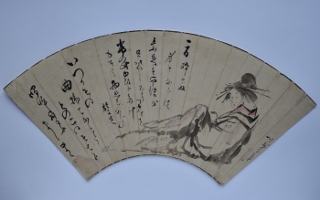
Click here to view image full size.
One of Hokusai’s best pupils. Known for his paintings of beauties but also designed some fine surimono. An original fan painting showing a reclining beauty. Sumi and light red on silvered paper, 7.25 x 17.75 in; 18.5 x 45.2 cms. Removed from a fan, so rib folds and other minor marks. Signed Hokuba ga.
Status: Available
Shunchosai HOKUSHU (Active 1822-32)
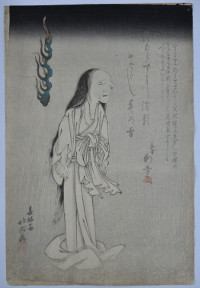
Click here to view image full size.
Onoe Kikugoro III as the ghost of Oiwa in Irohagana yotsuya kaidan, “Ghost Story of Yotsuya.” Performed at the Kado Theatre, 1/1826. Probably the best known Japanese ghost story and has been made into a number of films. Tamiya Iemon, a masterless samurai, murders the wife he has disfigured who comes back to haunt him until he is driven mad and subsequently killed by Oiwa’s brother. Evidently, Kikugoro’s performance was something of a sensation at the time as he gave a bravura performance playing both the ghost of Oiwa and Koheiji who were nailed on opposite sides of a panel dropped into the river. There are at least five states of this print. The first appears to be that illustrated in Roger Keyes, The Theatrical World Of Osaka Prints, Philadelphia Museum Of Art, 1973, no. 34, p. 108 with the engraver and two printers and the writing printed in silver. The example offered here appears to be a second state without the engraver and printers’ seal but with the writing still printed in silver. Other impressions with different seals and lacking the first three lines of writing and the silver are known. See The Tsubouchi Memorial Theatre Museum of Waseda University catalogue, Kamigata Prints in the former period: part 1, nos. 279 and 280. Also BM impression 1962,0210,0.2 which may be the last state.
Fine impression and colour with calligraphy in silver. Very good condition; full size. Signed Shunchosai Hokushu ga.
Status: Available
Keisai EISEN (1790-1848)
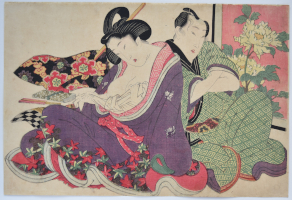
Click here to view image full size.
An amorous couple beside a screen decorated with a large chrysanthemum. From a set of twelve prints Keisei higo, “Secret Words of a Courtesan” published c 1822-25. Although coming under the heading of shunga, each print is an abuna-e design, without any graphic detail. Shows a courtesan with her client. She turns to tie the iwata-sash which indicates she is pregnant.
Fine impression. Very fine colour. Fine condition.
Status: Available
Katsushika HOKUSAI (1760-1849)
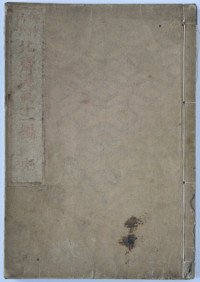
Click here to view image full size.
Volume 11 from the Manga. Front cover with original pink title slip: (Denshin kaishu) Hokusai manga juichihen, (“Transmitted from the Gods.”) “Hokusai’s Sketches, Vol. 11.” Original grey covers with burnished wave and diamond pattern. Inside front cover catalogue of newly published books; 2 pages preface and 29 numbered pages comprising 56 illustrations , 36 single page and 10 double page. 2 pages block-holders catalogue and inside back cover catalogue of newly published books. The extremely rare first edition published by Eirakuya Toshiro, Nagoya, c. 1834. The Manga was eventually completed in 15 volumes (the last two posthumously). The first 10 volumes published by Kadomaruya Jinsuke, Edo and Eirakuya Toshiro, Nagoya, 1814-1819; vols. 11 and 12 by Eirakuya only, c. 1834; vol. 13 by Eirakuya only, c. 1849; vol. 14 by Eirakuya only, c. 1850s; vol. 15 by Eirakuya only, 1878. Initially based on sketches produced on a visit to his friend and pupil Maki Bokusen in Nagoya in 1812. These sketches were collated by Bokusen and Katsushika Hoku’un and published in 1814. Other pupils collected sketches and so the set expanded. The books were enormously influential and popular, not just in Japan, but in the West and were endlessly reprinted giving rise to a plethora of late editions. In 1831, the German Phillip Franz von Siebold, reproduced images from the Manga in lithograph in his Archiv zur Beschreibung von Japon. They were also highly admired by the Impressionists, especially Manet and Bracquemond.
Fine impressions of the first edition. Some minor defects but otherwise in very good condition.
Status: Available
Tsukioka YOSHITOSHI (1839-1892)
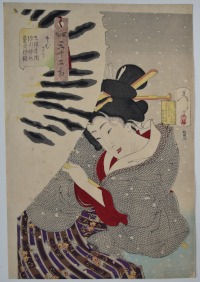
Click here to view image full size.
Samu-so: Tempo nenkan Fukagawa Nakamachi geisha fuzoku, “Looking Frozen: The Appearance of a Fukagawa Nakamachi Geisha in the Tempo Era [1830-1844].” Shows a beauty caught in a snowstorm, her umbrella laden with snow from a set Thirty-two Aspects of Women published by Tsunashima Kamekichi, 1888. The set depicts women of different backgrounds and occupations from the Kansei era through to the Meiji era with punning allusions to their situation or mood.
Very fine impression of the true first edition. Fine colour and condition. Signed Yoshitoshi ga.
Status: Available
Kitagawa UTAMARO (1753-1806)
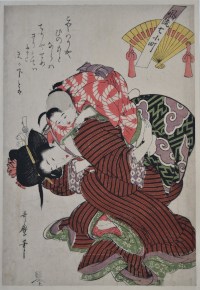
Click here to view image full size.
A beauty with a child on her back. Amagoi Komachi from a set Furyu nana Komachi, “Fashionable Seven Komachi.” Events from the life of Ono no Komachi, one of the six best waka poets of the Heian period. Published by Iseya Soemon, c. 1805.
Very good impression. Fine colour. Slight trimming, otherwise very good condition. Signed Utamaro hitsu.
Status: Available
Utagawa YOSHITSURU (Fl. c. 1840-50)
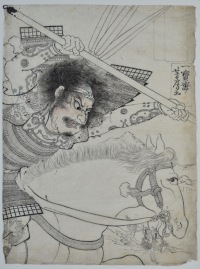
Click here to view image full size.
A fine original drawing by Yoshitsuru who was a pupil of Kuniyoshi. Sumi and slight colour on thin paper lightly adhered to a card, 13.25 x 10 in; 33.5 x 25.5 cms. The head drawn in great detail. Probably for an unpublished set of warrior prints. Shows a bajutsu samurai attacking an enemy on horseback.
In good condition apart from minor defects associated with a drawing’s survival. Signed Isseisai Yoshitsuru ga.
Status: Available
Kishi GANTAI (1782-1865)
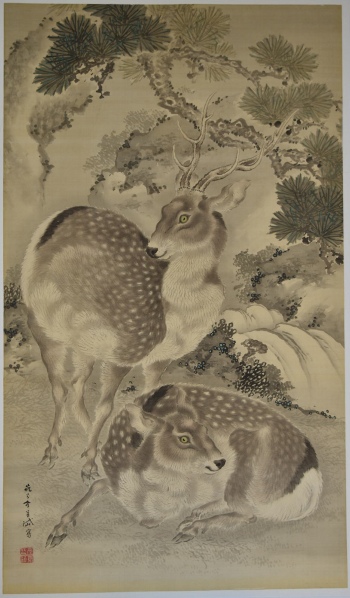
Click here to view image full size.
An extremely large painting, 55.5 x 32 in; 141 x 81.3 cms, sumi and light colour on silk. Shows a pair of Sika deer, their summer coats spotted and white. Gantai was the son and pupil of Ganku, and together with his brother, Renzan, carried on the Kishi school tradition. With his father, worked on the paintings for the new Kanazawa Castle in 1809. A highly accomplished painter, especially of kachoga. This is possibly the largest Gantai painting and it’s interesting to compare with the gajo by him also offered on this update. In very good condition. Framed and glazed. Signed Chikuzennosuke Gantai hitsu with seals Gantai and Kunchin.
Status: Available
Nagasawa ROSETSU ( 1754-1799 )

Click here to view image full size.
An original painting showing a white mouse and a spiny lobster on a tray. Rosetsu is considered one of the most important artists of the late Edo period but little is known of his short life ( he died at forty-five ) apart from the fact that he studied, and was one of the top disciples, of Maruyama Okyo. He is labelled an “eccentric” painter as he defies easy classification. His brushwork is a tour de force and he is known for his expressive depictions of animals. The Chinese-style inscription above is by Rosetsu’s friend Minagawa Kien who was a painter and scholar of Confucianism. It implies that the lobster and mouse are both signs of good fortune. Ink and light colour on paper. Image size 44.75 x 11.25 in; 113.75 x 28.5 cms.
Signed Rosetsu with seal Gyo. Painted 1790s. Inscription signed and sealed Kyosai. Slight foxing, otherwise in very good condition. One of the most copied painters. See Kono, Exhibition of Nagasawa Rosetsu, Chiba City Art Museum, 2000, pl. 42 for identical seals. Tsuji Nobu, Nagasawa Rosetsu: the Fanciful Painter, Miho Museum, 2011, pls. 19, 58-60, 67,87, 90, 91, 93 and 94.
Status: Available
Utagawa KUNIYOSHI (1797-1861)
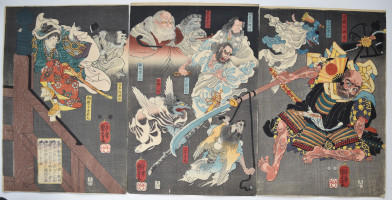
Click here to view image full size.
A triptych showing the famous battle on Gojo Bridge. The story relates how Benkei only needs one more blade to add to the 999 he has wrenched from samurai attempting to cross the bridge in order to fashion an invincible weapon. He meets Ushiwaka Maru (Minamoto no Yoshitsune’s childhood name) and challenges him to a fight on the bridge. Yoshitsune is aided by Sojobo, King of the Tengu (white-bearded in the centre) and other yamabushi tengu. Benkei loses the fight and becomes Yoshitsune’s loyal retainer. Published by Enshuya Hikobei, 1847-50. Robinson T194.
Fine impression, colour and condition. A lovely copy of this triptych. Signed Ichiyusai Kuniyoshi ga.
Status: Available
